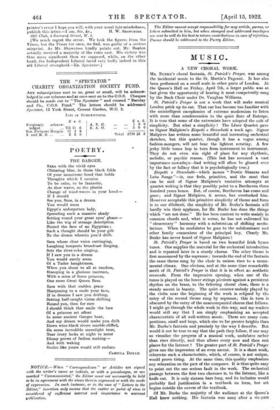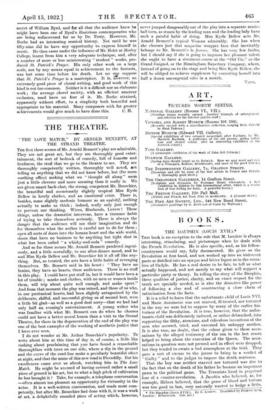MUS I C.
A NEW CHORAL WORK.
Ma. Bunan's choral fantasia, St. Patrick's Prayer, was among the incidental music to the St. Martin's Pageant. It has also been performed on a small scale in other parts of London. At the Queen's Hall on Friday, April 7th, a larger public was at last given the opportunity of hearing it most competently sung by the Bach Choir under Dr. Vaughan Williams.
St. Patrick's Prayer is not a work that will make musical London prick up its ear. That ear has become too familiar with the unintelligent cacophonies of extreme modernism to listen with more than condescension to the quiet flute of Euterpe. It is true that some of the extremists have adopted the cult of simplicity. But what a simplicity ! The Liner Quartet gave us Signor Malipiero's Rispetti e Strambotti a week ago. Signor Malipiero has written some beautiful and interesting orchestral sketches, but this quartet, though it has a vogue among fashion-mongers, will not bear the lightest scrutiny. A few jerky little tunes hop in turn from instrument to instrument. They do not even win right of place for any rhythmic, melodic, or psychic reason. (This last has assumed a vast importance nowadays—bad writing will often be glossed over by the fact or fallacy that it is psychologically true.) Bispetti e Strambotti—which means " Rustic Stanzas and Love Songs "—is, one feels, primitive, and the most that can be said of Signor Malipiero's tentative attempts at quartet writing is that they possibly point to a Beethoven three hundred years hence. But, of course, Beethoven has come and gone ; and Signor Malipiero, it seems, has overlooked him. However acceptable this primitive simplicity of theme and form is to our dilettanti, the simplicity of Mr. Burke's fantasia will hardly win their applause, for Mr. Burke has done the things which "are not done." He has been content to write mainly in common chords and, what is worse, he has not enlivened his " elementary " harmony with a substratum of shifting modu- lations. When he modulates he goes to the subdominant and other family connexions of the principal key. Clearly Mr. Burke has never heard of Signor Malipiero !
St. Patrick's. Prayer is based on two beautiful Irish hymn tunes. One supplies the material for the orchestral introduction and is repeated later in a sturdy chorus. The other theme is first announced by the sopranos ; towards the end of the fantasia the same theme sung by the choir in unison rises to a monu- mental climax. One obvious, and at the same time remarkable merit of St. Patrick's Prayer is that it is in effect an aesthetic crescendo. From the impressive opening, when one of the tunes is played on the lower strings pizzicato against a persistent rhythm on the brass, to the faltering choral close, there is a steady ascent in beauty. The quiet counter-melody played by the violin near the beginning of the work is eclipsed by the entry of the second theme sung by sopranos; this in turn is obscured by the entry of the unaccompanied chorus that follows. I might go through the whole work in this way, and my readers would still say that I am simply emphasizing an accepted characteristic of all well-written music. There are many com- positions, small and large, which rise to far greater heights than Mr. Burke's fantasia and precisely by the way I describe. But would it not be true to say that the path they follow, if one may so visualize the progress of a musical work, undulates rather than rises directly, and thus allows every now and then rest places for the listener ? The greater part of St. Patrick's Prayer gives one the impression of an even ascent. It is a short work, otherwise such a characteristic, which, of course, is not unique, would prove tiring. At the same time, this quality emphasizes any relaxation on the part of the composer. It is thus quite easy to point out the one serious fault in the work. The orchestral passage between the first two choruses is, to the listener, like a knife cut. It is only sixteen bars long, and its inclusion would probably find justification in a textbook on form, but art begins outside the covers of the textbook.
Of Mr. Burke the majority of the audience at the Queen's Hall knew nothing. His fantasia was sung after a six-part motet of William Byrd, and for all that the audience knew he might have been one of Byrd's illustrious contemporaries who are being rediscovered for us by Dr. Terry. However, Mr. Burke had an interesting musical history. Not until he was fifty-nine did he have any opportunity to express himself in music. He then came under the influence of Mr. Hoist at Morley College, learnt from him a very adequate technique, and, after a number of more or less uninteresting " student " works, pro- duced St. Patrick's Prayer. His only other work on a large scale, not by any means equal in achievement to the fantasia, was lost some time before his death. Let no 434e suppose that St. Patrick's Prayer is a masterpiece. It is, however, an extremely good piece of choral writing, and good work of this kind is not too common. Neither is it a difficult nor an elaborate work ; the average choral society, with an efficient amateur orchestra, need have no fear of it. Mr. Burke attained, apparently without effort, to a simplicity both beautiful and appropriate to his material. Many composers with far greater
achievements would give much to have done this. C. H.



































 Previous page
Previous page